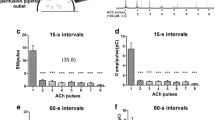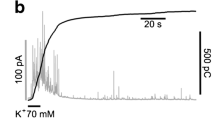Abstract
The present study provides evidence for a number of calcium pools important in histamine secretion from the mast cell. Firstly, calcium loosely bound to the cell membrane, and in rapid equilibrium with the extracellular environment, may be utilized for histamine release induced by most secretagogues. Secondly, all inducers are able to mobilize deeply buried or internal stores of calcium to initiate exocytosis. Finally, calcium bound to regulatory sites in the membrane may modulate the secretory process. Removal of calcium from the latter sites by brief treatment with chelating agents markedly enhances the secretory response in the absence of extracellular calcium, probably by facilitating the mobilization of bound stores of the ion. Saturation of these sites in the presence of excess calcium inhibits the release process and may restrict influx of the cation.
Similar content being viewed by others
References
W. Kazimierczak andB. Diamant,Mechanisms of Histamine Release in Anaphylactic and Anaphylactoid Reactions, Prog. Allergy24, 295–365 (1978).
M.J. Berridge,The Interactions of Cyclic Nucleotides and Calcium in the Control of Cellular Activity, Adv. cyclic Nuc. Res.6, 1–97 (1975).
J.C. Foreman, M.B. Hallett andJ.L. Mongar,The Relationship Between Histamine Secretion and 45 Calcium Uptake by Mast Cells, J. Physiol.271, 193–214 (1977).
J.H. Baxter andR. Adamik,Differences in Requirements and Actions of Various Histamine-Releasing Agents, Biochem. Pharmac.27, 497–503 (1978).
D.E. Cochrane andW.W. Douglas,Calcium-Induced Extrusion of Secretory Granules (Exocytosis) in Mast Cells Exposed to 48/80 or the Ionophores A-23187 and X537A, Proc. nat. Acad. Sci. USA71, 408–412 (1974).
G. Atkinson, M. Ennis andF.L. Pearce,The Effect of Alkaline Earth Cations on the Release of Histamine from Rat Peritoneal Mast Cells Treated with Compound 48/80 and Peptide 401, Br. J. Pharmac.65, 395–402 (1979).
F.L. Pearce, G. Atkinson andM. Ennis,Studies on Histamine Release Induced by Compound 48/80 and Peptide 401, Agents and Actions9, 63–64 (1979).
F.L. Pearce, G. Atkinson, M. Ennis, A. Truneh, P.M. Weston andJ.R. White,Effect of Anti-Allergic Compounds on Histamine Release Induced by Basic Agents, Antigen and the Calcium Ionophore A23187, in:The Mast Cell, its Role in Health and Disease, (Eds. J. Pepys andA.M. Edwards; Pitman Medical, Tunbridge Wells 1979), pp. 69–75.
M. Ennis andF.L. Pearce,Effect of Cyclic AMP on Histamine Release Induced by Compound 48/80, Int. Archs Allergy appl. Immun.60, 461–464 (1979).
M. Ennis, A. Truneh, J.R. White andF.L. Pearce,Calcium Pools Involved in Histamine Release from Rat Mast Cells, Int. Archs Allergy appl. Immun.62, 467–471 (1980).
M. Ennis, G. Atkinson andF.L. Pearce,Inhibition of Histamine Release Induced by Compound 48/80 and Peptide 401 in the Presence and Absence of Calcium. Implications for the Mode of Action of Anti-Allergic Compounds, Agents and Actions10, 222–228 (1980).
M. Ennis, F.L. Pearce andP.M. Weston,Some Studies on the Release of Histamine from Mast Cells Stimulated with Polylysine, Br. J. Pharmac.70, 329–334 (1980).
P.A. Shore, A. Burkhalter andV.H. Cohn,A Method for the Fluorometric Assay of Histamine in Tissues, J. Pharmac. exp. Ther.127, 182–186 (1959).
N. Grosman andB. Diamant,Studies on the Role of Calcium in the Anaphylactic Histamine Release from Isolated Rat Mast Cells, Acta pharmac. tox.35, 284–292 (1974).
J.C. Foreman andL.G. Garland,Desensitization in the Process of Histamine Secretion Induced by Antigen and Dextran, J. Physiol.239, 381–391 (1974).
J.C. Foreman andJ.L. Mongar,The Action of Lanthanum and Manganese on Anaphylactic Histamine Secretion, Br. J. Pharmac.48, 527–537 (1973).
B. Diamant andS.A. Patkar,Stimulation and Inhibition of Histamine Release from Isolated Rat Mast Cells. Dual Effects of the Ionophore A23187, Int. Archs Allergy appl. Immun.49, 183–207 (1975).
L. Hurwitz, P.D. Joiner andS. Von Hagen,Calcium Pools Utilized for Contraction in Smooth Muscle, Am. J. Physiol.213, 1299–1304 (1967).
L. Hurwitz, P.D. Joiner andS. Von Hagen,Mechanical Responses of Intestinal Smooth Muscle in a Calcium-Free Medium, Proc. Soc. exp. Biol. Med.125, 518–522 (1967).
Author information
Authors and Affiliations
Rights and permissions
About this article
Cite this article
Pearce, F.L., Ennis, M., Truneh, A. et al. Role of intra- and extracellular calcium in histamine release from rat peritoneal mast cells. Agents and Actions 11, 51–54 (1981). https://doi.org/10.1007/BF01991455
Issue Date:
DOI: https://doi.org/10.1007/BF01991455




